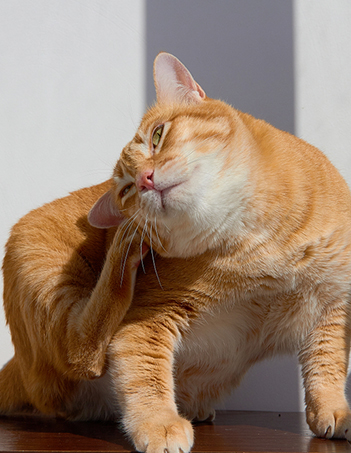Home | Resources | Ear Canal and Nasopharyngeal Polyps in Cats
Ear Canal and Nasopharyngeal Polyps in Cats
Keywords:
Ear Canal and Nasopharyngeal Polyps in Cats
At Canton Animal Hospital, we treat a variety of feline ear disorders, including ear canal and nasopharyngeal polyps, which are among the most common non-cancerous growths seen in young cats. These polyps are inflammatory growths that arise from the lining of the middle ear (tympanic bulla), auditory (Eustachian) tube, or nasopharynx (upper throat area). While benign, they can cause significant discomfort, infection, and breathing or swallowing issues if left untreated.
Although the exact cause is unknown, polyps are thought to develop in response to chronic inflammation or viral infections, such as feline herpesvirus. They are most often diagnosed in young adult cats, though they can occur at any age.
Signs of Ear and Nasopharyngeal Polyps in Cats
Chronic ear discharge or odor
Head shaking or scratching at one ear
Sneezing or nasal discharge
Gagging, retching, or difficulty swallowing
Noisy breathing or snoring
Head tilt or loss of balance (vestibular signs)
Facial nerve paralysis (drooping of the eyelid, lip, or ear)
Third eyelid elevation or abnormal pupil size (Horner’s syndrome).
Featured Resources

We Welcome New Patients!
We're always happy to give your furry friend care at our hospital. Get in touch today!
Contact Us
How Are Polyps Diagnosed?
Diagnosing a polyp requires a thorough physical and otoscopic examination. If inflammation or discharge obstructs visibility, initial medical treatment may be needed before imaging or sampling.
Otoscopy – Visual inspection of the ear canal and eardrum
Oropharyngeal exam – Visualization of the back of the throat to identify nasopharyngeal growths
Advanced imaging (CT scan or X-rays) – Evaluates the extent of the mass and involvement of the middle ear
Biopsy or cytology – Confirms polyp and rules out other masses
Viral testing – May be recommended in recurring cases
Treatment: Traction vs. Surgery
The best approach to treating feline polyps depends on their size, location, and recurrence.
Traction Removal:
Involves grasping and gently pulling the polyp out through the ear canal or oral cavity
Suitable for small, accessible polyps
Requires sedation or light anesthesia
High recurrence rate (up to 50%) if the base is not removed
May provide temporary relief but is rarely curative
Surgical Treatment – Ventral Bulla Osteotomy (VBO):
VBO is the gold standard for definitive treatment of ear canal and nasopharyngeal polyps, especially when the polyp originates from the middle ear.
Involves creating a small incision under the jaw to access the tympanic bulla
Allows complete removal of the polyp along with its base
Reduces the risk of regrowth and secondary infection
Recommended when traction removal fails or in cases of recurrent polyps
Often curative in a single, well-performed procedure
In some cases, both traction removal and VBO are combined-traction is used to remove the visible portion of the polyp, followed by VBO to eliminate the remaining root inside the bulla.
Post-Operative Care and Recovery
Hospitalization is usually 24–48 hours for pain management and monitoring
Medications include antibiotics, anti-inflammatories, and sometimes antivirals
Restricted activity for 1–2 weeks with use of an E-collar
Follow-up exams are scheduled to monitor healing and assess for recurrence
Side effects such as Horner’s syndrome or mild facial nerve weakness are possible, especially in cats, but these are often temporary and improve with time.
Prognosis
Excellent prognosis with complete surgical removal via VBO
Recurrence rate is low with proper technique and post-op care
Cats generally return to normal activity and quality of life within a few weeks
Schedule a Consultation
If your cat is showing signs of chronic ear issues, sneezing, or unusual breathing sounds, they may have a nasopharyngeal or ear polyp. Contact Canton Animal Hospital for a comprehensive evaluation.
📞 Call us today or Request an Appointment Online to schedule your cat’s exam.
Featured Resources

We Welcome New Patients!
We're always happy to give your furry friend care at our hospital. Get in touch today!
Contact UsFrequently Asked Questions (FAQs) About Ear Polyps
If your cat has been diagnosed with an ear or nasopharyngeal polyp—or is showing symptoms like sneezing, head shaking, or breathing issues—you likely have questions. Below are answers to the most common concerns cat owners have about polyps and their treatment.
